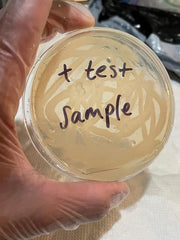

April 27, 2021
Experiment On Five Gallon Water Jug With Spout Reveals Potentially Harmful Bacteria

People who either do not trust municipal water sources or simply do not like the taste or smell of their tap water often rely on water stores. These retail outlets offer purified drinking water typically filled in five gallon jugs with spout dispensers.
Sometimes when filling up water containers, plastic bags are seen placed over the spigots. Customers want to protect the spouts during filling or while the spouts are close to the floor of the car during transport. At home, there is a worry that fruit flies or other pests will come in contact with the spout. Pet owners worry that their pets may try to sip from the dispenser.
Do spouts on water jugs get dirty during transport, or at home? And if a Spigcap™ is used, does it create a meaningful difference in cleanliness?
Milunova conducted a comparative test using two five gallon water jugs over a weeklong experiment. One was left exposed and one had a Spigcap™ attached. The water jugs were transported in a car as usual to be filled, then alternated to be placed on a countertop or storage area for three days. One sample of each spigot was taken with a swab and used as a control. After one week, another sample was taken of each spigot and placed on Evviva bacterial agar plates. The plates were incubated at 90 F for four days in sealed bags using a sous vide bath thermal regulator.
Additional samples were taken to observe bacteria that would commonly be present around the house. These samples included: the sink drain to establish a positive control, the TV remote, and a washed blue berry that was stored in the refrigerator.
The results of the household items were as follows. The blueberry sample showed what could be some type of mold growth, which would be common for fruit. The controller sample showed a white and yellow spotted bacterial growth. The sink drain positive test sample showed densely spotted dark yellow bacteria which grew in streaks along the path on which the cotton swab was rubbed.



The sample obtained from the spout covered by the Spigcap™ showed some light yellow spotted bacteria growth along the path of the cotton swab. The sample from the open air spout with no cap showed pink to red spotted bacteria growing along the cotton swab path.


Bacteria cultures were present in every agar plate that was incubated, highlighting the ubiquitousness of bacteria in daily life. While there is good and harmful bacteria, the exact type present in the plates remains a mystery, and without lab equipment to properly identify each type of bacteria that was present, the only option is a visual comparison among the samples collected.
Interestingly, the most distinct bacteria colony is the pinkish red colony that grew from the sample collected on the spout which did not use a cap. With the limited information available, one possibility is that it is a Gram-negative bacteria, while the other colonies are Gram-positive.
Gram-negative bacteria colonies could be worse due to the presence of their outer membranes which protects them from antibiotics and other means to sterilize them.
One possibility is that the pinkish red spotted bacteria may be Serratia Marcescens, but for now that remains inconclusive.
One important distinction among the samples is that all the samples except one looked like what may be identified as common household bacteria - either white or yellowish spotted or moldy bacteria. The one sample that did not fit this category is the one which was exposed to the outer elements without a cap or other type of barrier. One possible conclusion is that the spout with no cap was exposed to a bacteria during the refill trip and possibly while being transported. It is important to note that the bacteria cultures grew under ideal conditions, and that bacteria may not proliferate under normal conditions.
For a more detailed account of the experiment please visit the Milunova blog.
Spigcap™ is made from durable food-grade silicone which is naturally BPA free, thermally stable, and has low chemical reactivity. It fits tightly around most standard spigots and maintains a barrier from the spout and fluids in the container against dusts, pests, and harmful bacteria. The user friendly design keeps spigots clean and prevents spillage when the container is tilted by clipping on to the stem. Wholesale pricing is also available. Patent Pending.
If you would like to stop worrying about contamination, order your Spigcap™ 3-pack.

Originally published on PRLog.